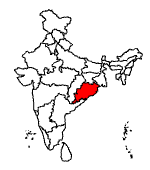
Dimdima
Online Children's Magazine from India

Dimdima
Online Children's Magazine from India
Orissa, on India's east coast is steeped in history and cultural traditions and is richly endowed with mineral wealth. But sadly, it remains one of India's most under developed states.
Area: 1,55,707 sq km
Population : 3,67,06,920 includes over sixty Adivasi groups.
Main Language : Oriya
Capital : Bhubaneswar
Major Cities :
The two major cities of the state are Bhubaneswar the capital and Cuttack, which lie within 10 kilometres of each other. Puri and Konark are within 60 kilometres of Bhubaneswar; the triangle of Puri, Konark and Bhubaneswar is referred to as Orissa's "golden triangle."
Major Rivers :
The Mahanadi, the Brahmani and the Vaitarani
Physiography :
The state consists of an extensive plateau in the interior which gradually slopes to form a wide coastal plain along the Bay of Bengal. Three important rivers, the Mahanadi, the Brahmani and the Vaitarani flow through the state in a southeasterly direction before meeting the sea. The Hirakud dam built on the Mahanadi near Sambalpur is one of the world's longest dams.
Rourkela and Angul-Nalconagar, which has Asia's largest aluminium plant, are its major industrial cities. Other industrial towns are Rajganpur, Belpahar, Talcher, Koraput, Jeypur and Brajarajnagar. Paradeep is Orissa's only modern port and is slowly being rebuilt after the devastating cyclone of October'99.
Puri, Chandipur and Gopalpur are fast becoming popular beach resorts.
Besides its many ancient and historical monuments, Orissa can boast of beautiful beaches, wild life sanctuaries and a rich handicraft tradition.
More than 2000 years ago, in 261 B.
C, Ashoka the Mauryan king invaded Kalinga. The widespread destruction and savagery that characterised the war made the war-mongering monarch turn to Buddhism and the path of peace.
In the 1st century B.C. Orissa became a powerful country under its ruler Kharavela. With the death of Kharavela, Orissa passed into obscurity.
In the mid-9th century, the eastern Gangas emerged as the foremost power in the region. The greatest of the Ganga rulers was Anantavarman Chodaganga whose dominion extended from the Ganga to the Godavari.
Early in the 12th century he built the famous Jagannath Temple at Puri. A later ruler, Narasimha Deva I, built the Sun temple at Konarak.
The last Ganga king, Bhanudeva III was overthrown by his minister, Kapilendra, founder of the Suryavamsa Dynasty.
Orissa came under Mughal jurisdiction in 1568. In 1765, the Mughal emperor Shah Alam II granted the British the right to collect revenue from Bengal, Bihar and Orissa.
Eventually the British occupied Orissa. From the 19th century onwards, leaders of Orissa waged a
prolonged and persistent agitation to unite the many Oriya-speaking areas lying in different provinces. Finally the province of Orissa was created on 1 April, 1936.
After independence on 19 August 1949, the princely states were also merged with Orissa, and the modern state of Orissa came into being.
The temples of Orissa have always been famous.
Bhubaneshwar, the capital, is studded with temples. The Lingaraj temple was built in the 7th century AD.
Puri, on the coast, is one of the four holy pilgrimage sites in India. Jagannath, Balabhadra and Subhadra are the presiding deities of the Jagannath temple, one of Orissa's more prominent landmarks. In Konark is the Sun temple, or the "Black Pagoda". The temple was conceived as a giant celestial chariot with twenty-four carved wheels drawn by seven horses.
Odissi, Orissa's traditional dance form, is well known for its grace, elegance and beauty. There are several other traditional and tribal dances of great skill and artistic excellence, like the Chhau Nacha of Mayurbhanj district.
Orissa's coastline is dotted with several beaches. Puri is the most popular, but there are equally outstanding ones at Chandipur, Konark, Chandeshwar and Gopalpur-on-Sea.
Orissa also draws several wildlife enthusiasts. The Nandankanan Biological Park, famous for its white tigers and the Chandaka elephant reserve lie near Bhubaneshwar.
Chilika is the largest brackish water lake in the country and attracts a large number of migratory birds. A large population of Gangetic dolphins also inhabits the lake.
Dola, as Holi is popularly called, is one of the most colourful festivals of Orissa. Sitalasasthi is observed to mark the marriage of Shiva with Parvati. But the grandest of all festivals is the Rath Yatra or the Car Festival, celebrated around the months of June or July. Ardent devotees carry the idols of Lord Jagannath and his siblings to the Gundicha Mandir. To commemorate the glorious past, when people of Orissa sailed on commercial voyages to the Indonesian islands, a big fair called Bali Yatra is held on the banks of the Mahanadi at Cuttack in November.



Dimdima is the Sanskrit word for ‘drumbeat’. In olden days, victory in battle was heralded by the beat of drums or any important news to be conveyed to the people used to be accompanied with drumbeats.
Bharatiya Vidya Bhavan
K. M Munshi Marg,
Chowpatty, Mumbai - 400 007
email : editor@dimdima.com
Bharatiya Vidya Bhavan
505, Sane Guruji Marg,
Tardeo, Mumbai - 400 034
email : promo@dimdima.com
Dimdima.com, the Children's Website of Bharatiya Vidya Bhavan launched in 2000 and came out with a Printed version of Dimdima Magazine in 2004. At present the Printed Version have more than 35,000 subscribers from India and Abroad.